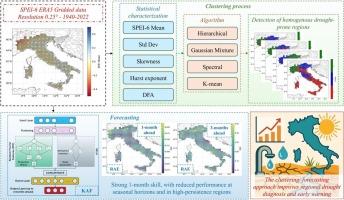意大利干旱的解剖:统计特征、时空持续性和预测潜力
IF 6.3
1区 地球科学
Q1 ENGINEERING, CIVIL
引用次数: 0
摘要
干旱是一种多方面的灾害,在地中海地区具有深远的社会环境后果,意大利是气候脆弱性热点地区的典型代表,其空间异质性显著,气候压力不断加剧。本研究通过对意大利6个月标准化降水-蒸散指数(SPEI-6)时间序列进行综合分析,整合高阶统计描述符、基于Hurst指数(H)和去趋势波动分析(DFA)的持续性诊断、先进的聚类算法和深度学习预测,推进了干旱研究。与传统的均方差评估不同,该分析强调偏度和其他高阶矩来捕捉干旱强度和频率的不对称性,并采用尺度度量来量化水文气候信号的长期依赖性和记忆性。一套比较的聚类方法,包括K-means、聚集分层、高斯混合模型和光谱聚类,描绘了一个连贯的三方干旱结构:一个具有强时间记忆和长期干旱的持续的南部和岛屿区域,一个中等持久性的东北走廊,以及一个以弱持久性、高可变性和突变为特征的不稳定的西北高山区域。采用Kolmogorov-Arnold傅里叶(KAF)网络的预测实验,以长短期记忆(LSTM)架构为基准,揭示了在领先一个月的情况下,特别是在持续的南部和岛屿地区,而在季节性视野和高度变化的北部地区,表现下降。这些发现突出表明,有必要根据地区情况进行监测和制定适应性管理战略。本文提出的方法框架具有模块化和可转移性,为地中海和其他干旱易发地区面临日益加剧的气候变化的干旱诊断和预警提供了一个严格和可复制的模板。本文章由计算机程序翻译,如有差异,请以英文原文为准。

The anatomy of drought in Italy: statistical signatures, spatiotemporal persistence, and forecasting potential
Drought is a multifaceted hazard with profound socio-environmental consequences in the Mediterranean, where Italy exemplifies a climate vulnerability hotspot shaped by pronounced spatial heterogeneity and intensifying climatic pressures. This study advances drought research by conducting a comprehensive analysis of six-month Standardized Precipitation–Evapotranspiration Index (SPEI-6) time series across Italy, integrating higher-order statistical descriptors, persistence diagnostics based on the Hurst exponent (H) and Detrended Fluctuation Analysis (DFA), advanced clustering algorithms, and deep learning forecasting. Distinct from conventional mean–variance assessments, the analysis emphasizes skewness and other higher-order moments to capture asymmetries in drought intensity and frequency, and employs scaling metrics to quantify long-range dependence and memory in hydroclimatic signals. A comparative suite of clustering approaches, including K-means, Agglomerative Hierarchical, Gaussian Mixture Models, and Spectral Clustering, delineates a coherent tripartite drought structure: a persistent southern and insular regime with strong temporal memory and prolonged droughts, an intermediate northeastern corridor with moderate persistence, and a volatile northwestern Alpine domain characterized by weak persistence, high variability, and abrupt transitions. Forecasting experiments employing Kolmogorov–Arnold Fourier (KAF) networks, benchmarked against Long Short-Term Memory (LSTM) architectures, reveal substantial skill at one-month lead, particularly in persistent southern and insular regions, while performance declines at seasonal horizons and in highly variable northern areas. These findings highlight the necessity of regionally tailored monitoring and adaptive management strategies. The methodological framework presented here, modular and transferable, provides a rigorous and replicable template for drought diagnosis and early warning in Mediterranean and other drought-prone regions facing escalating climate variability.
求助全文
通过发布文献求助,成功后即可免费获取论文全文。
去求助
来源期刊

Journal of Hydrology
地学-地球科学综合
CiteScore
11.00
自引率
12.50%
发文量
1309
审稿时长
7.5 months
期刊介绍:
The Journal of Hydrology publishes original research papers and comprehensive reviews in all the subfields of the hydrological sciences including water based management and policy issues that impact on economics and society. These comprise, but are not limited to the physical, chemical, biogeochemical, stochastic and systems aspects of surface and groundwater hydrology, hydrometeorology and hydrogeology. Relevant topics incorporating the insights and methodologies of disciplines such as climatology, water resource systems, hydraulics, agrohydrology, geomorphology, soil science, instrumentation and remote sensing, civil and environmental engineering are included. Social science perspectives on hydrological problems such as resource and ecological economics, environmental sociology, psychology and behavioural science, management and policy analysis are also invited. Multi-and interdisciplinary analyses of hydrological problems are within scope. The science published in the Journal of Hydrology is relevant to catchment scales rather than exclusively to a local scale or site.
 求助内容:
求助内容: 应助结果提醒方式:
应助结果提醒方式:


